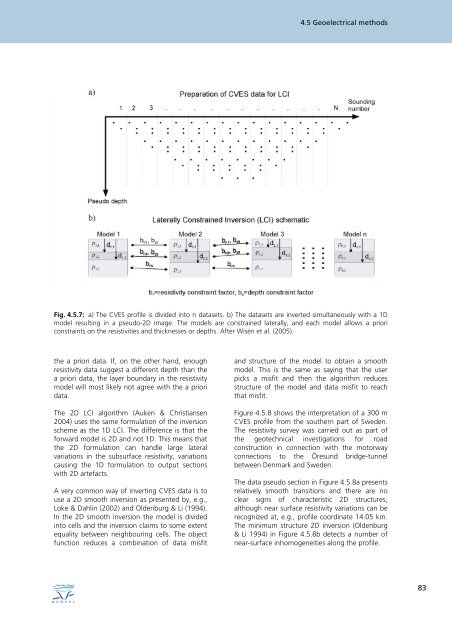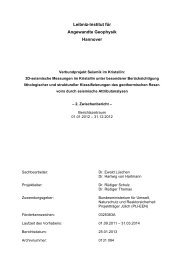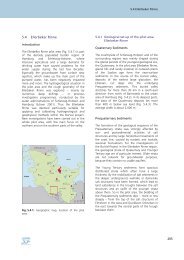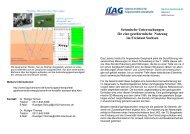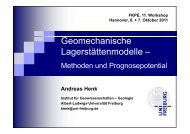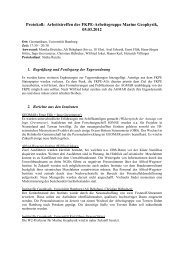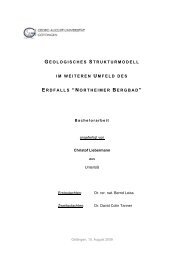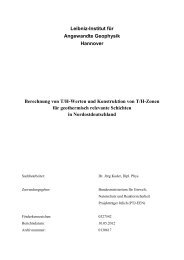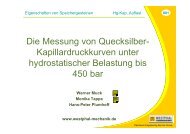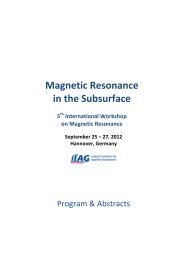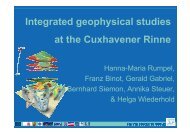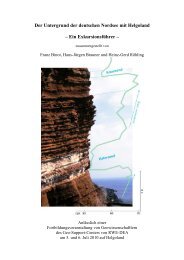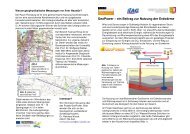4.5 Geoelectrical methods - LIAG
4.5 Geoelectrical methods - LIAG
4.5 Geoelectrical methods - LIAG
You also want an ePaper? Increase the reach of your titles
YUMPU automatically turns print PDFs into web optimized ePapers that Google loves.
<strong>4.5</strong> <strong>Geoelectrical</strong> <strong>methods</strong><br />
Fig. <strong>4.5</strong>.7: a) The CVES profile is divided into n datasets. b) The datasets are inverted simultaneously with a 1D<br />
model resulting in a pseudo-2D image. The models are constrained laterally, and each model allows a priori<br />
constraints on the resistivities and thicknesses or depths. After Wisén et al. (2005).<br />
the a priori data. If, on the other hand, enough<br />
resistivity data suggest a different depth than the<br />
a priori data, the layer boundary in the resistivity<br />
model will most likely not agree with the a priori<br />
data.<br />
The 2D LCI algorithm (Auken & Christiansen<br />
2004) uses the same formulation of the inversion<br />
scheme as the 1D LCI. The difference is that the<br />
forward model is 2D and not 1D. This means that<br />
the 2D formulation can handle large lateral<br />
variations in the subsurface resistivity, variations<br />
causing the 1D formulation to output sections<br />
with 2D artefacts.<br />
A very common way of inverting CVES data is to<br />
use a 2D smooth inversion as presented by, e.g.,<br />
Loke & Dahlin (2002) and Oldenburg & Li (1994).<br />
In the 2D smooth inversion the model is divided<br />
into cells and the inversion claims to some extent<br />
equality between neighbouring cells. The object<br />
function reduces a combination of data misfit<br />
and structure of the model to obtain a smooth<br />
model. This is the same as saying that the user<br />
picks a misfit and then the algorithm reduces<br />
structure of the model and data misfit to reach<br />
that misfit.<br />
Figure <strong>4.5</strong>.8 shows the interpretation of a 300 m<br />
CVES profile from the southern part of Sweden.<br />
The resistivity survey was carried out as part of<br />
the geotechnical investigations for road<br />
construction in connection with the motorway<br />
connections to the Öresund bridge-tunnel<br />
between Denmark and Sweden.<br />
The data pseudo section in Figure <strong>4.5</strong>.8a presents<br />
relatively smooth transitions and there are no<br />
clear signs of characteristic 2D structures,<br />
although near surface resistivity variations can be<br />
recognized at, e.g., profile coordinate 14.05 km.<br />
The minimum structure 2D inversion (Oldenburg<br />
& Li 1994) in Figure <strong>4.5</strong>.8b detects a number of<br />
near-surface inhomogeneities along the profile.<br />
83


